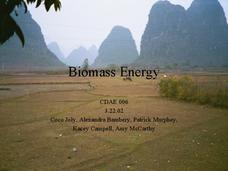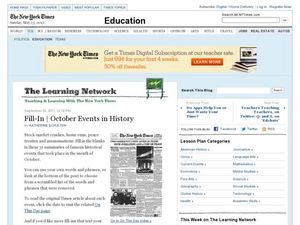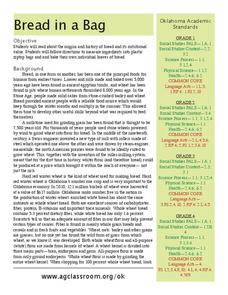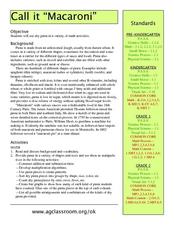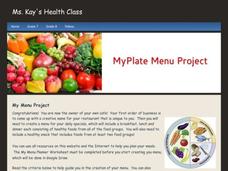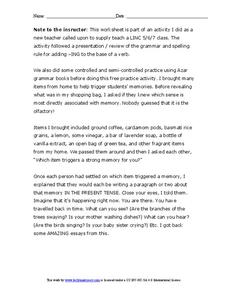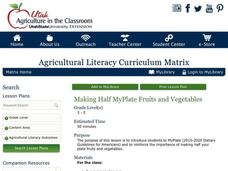Curated OER
Early 18c Europe: Proto-Industrialism
Providing key information, visually appealing pictures, and thought-provoking questions, this series of slides presents your class with a study of 18th century Europe as it becomes increasingly urbanized. From peasants to princes, the...
Curated OER
Starch
Students examine the basics of starch and how it is used in food. In this photosynthesis lesson students experiment with variables that affect starch production in photosynthesis.
Curated OER
Biomass Energy
Consider biomass as an alternative energy source with this PowerPoint. Environmental science pupils discover the potential of converting gases produced by landfills into useful energy. They compare and contrast environmental and economic...
Curated OER
Fill-In - October Event in History
A lot has happened in the month of October in the past 100 years or so. Kids fill in the blank for 31 events, each of which occurred on a day in October. Each event can be found in a New York Times article from the past 100+ years....
Curated OER
Inferences Using Evidence
What is an inference, and how can you use textual evidence to create one? Introduce your developing readers to the world of inferencing with this presentation. Terms are defined, and several examples are shown. The class works together...
Curated OER
Bread in a Bag
Could the history of bread really be interesting? Yes, it could! An informational text gives scholars wheat production background from 8,000 years ago, discussing different types of bread and the current industry in Oklahoma. Learners...
Curated OER
Call it "Macaroni"
Who knew there were so many fun educational opportunities featuring pasta? Scholars read a brief informational text about the history of pasta (note that "macaroni" is spelled two different ways, so address this if kids are reading...
Curated OER
Energy Plus!
"Energy Plus!" from Together Counts is three days worth of lessons, discussions, and activities about nutrition. The materials help you teach youngsters about eating healthy and burning calories. Energy in and energy out. Included are...
National Park Service
Erosion
A set of PowerPoint slides supports a lecture or class review of weathering and erosion. Viewers learn the definition of each and examine various photos for evidence. Erosion is further depicted as caused by wind, water, and ice....
Texas State Energy Conservation Office
Investigation: Water Wheel
Middle school scientists construct a working water wheel from an aluminum pie pan. Because of the sharp edges on the cut aluminum, this activity is for mature learners only. You could have your class compete to see whose wheel can lift...
Weebly
My Menu Project
If you don't mind using another teacher's website, this one has a simple project that would make a nice conclusion to your nutrition unit. Using a planning worksheet and peer review, nutrition nuts create a cafe menu using healthy foods....
Texas Heart Institute
Nutrition: How Do I Choose the Right Foods?
Young learners discuss how to practice healthy eating habits and the body's need for energy through discussion and exploration of the MyPlate system.
Garden Earth Naturalist Club
Parts of a Flower! Flower Dissection
Sometimes the best way to learn about plants is to see the different parts of a plant yourself. Groups of learners dissect flowers to answer questions about what they observe and what they wonder about their flower.
North Clackamas School District
Context Clues: Synonyms
What do you do when you find a word that's not familiar to you? Help readers use context clues when encountering unfamiliar words with a grammar activity. They note the parts of the sentences that show the meaning of the word,...
Virginia Department of Education
Adaptation and Evolution
Um may be the atomic symbol for confusion, but it won't be needed in this lesson. Scholars rotate through seven stations completing experiments, hands-on activities, writing exercises, and analysis. Stations include material on...
Practical Action
The Wind Power Challenge
Up it goes! Groups must design and build a windmill able to lift a weight. The packet includes discussion points to use prior to the build that cover topics such as variables, fairness, and the design process.
DiscoverE
Puff Mobiles
You've probably heard of solar-powered cars, but what about wind-powered cars? Scholars build cars that can travel at least six feet. They can only use their breath to move the car—so, obviously, a sail might be a good feature for the...
DiscoverE
Working with Watermills
Water is a powerful force; harness it through watermills. The task at hand is to create a simple watermill that functions in flowing water for at least three minutes. Scholars work together in teams to design and construct such a...
DiscoverE
Shaky Ground
You're on solid ground if you decide to use the resource. A simple activity has young engineers investigate the problem of liquefaction. A battery placed on dry sand will stay standing—but not if scholars add water to the cup.
Curated OER
Scent-Inspired Composition
Our sense of smell has a wonderful way of bringing back memories. Unlock those memories with an olfactory-inspired writing prompt that challenges writers to tell a story about a specific smell and the memories it conjures.
Agriculture in the Classroom
Making Half MyPlate Fruits and Vegetables
Establish healthy eating habits with a instructional activity focused around MyPlate's food recommendations and the importance of eating fruits and vegetables. Through class discussion and worksheet completion, scholars discuss the best...
Kenan Fellows
How Does an Unhealthy Diet Influence our Health and Well-Being?
You are what you eat, or so they say! After surveying family and friends on a week of eating habits, learners analyze the data for patterns. They compare different variables such as fats and cost, fats and calories, or fats and LDLs.
Glynn County School System
Solar System Formation and Extra-Solar Planets
Has the solar system always been like it is today? A lesson presentation begins with a discussion of the formation of our solar system. It continues with a compare and contrast of the inner and outer planets.
Purdue University
Design of an Earthen Dam for a Lafayette Neighborhood
How do dams support bodies of water? Scholars engage in a hands-on STEM activity where they design, build, and test dams to learn about bodies of water and how humans use natural resources. They learn how criteria and constraints affect...
Other popular searches
- Whole Grains
- Bread and Grains
- Cereal Grains
- Food Pyramid Grains
- Difference Between Grains
- Plant Products Grains
- Breakfast Cereal Grains
- Sand Grains
- Foods Meat and Grains
- Igneous Rock Grains
- What Are Grains
- Cooking Grains


